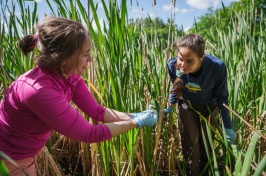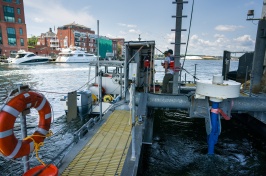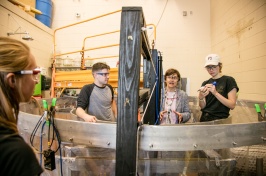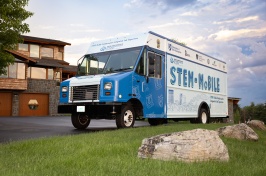Green Infrastructure Grant to Help N.H. Communities Manage Stormwater
DURHAM, N.H. - A pair of grants to the University of New Hampshire Stormwater Center will help communities in the Great Bay watershed better manage stormwater- runoff from rainfall that is not absorbed into the ground - with innovative "green" infrastructure.
With $600,000 from the National Estuarine Research Reserve System (NERRS) Science Collaborative grant, a partnership between UNH and the National Oceanic and Atmospheric Administration (NOAA), the Stormwater Center will give New Hampshire's 42 coastal watershed communities much-needed support in reducing stormwater runoff and its related costs of pollution and flooding. A second grant from the New Hampshire Department of Environmental Services (N.H. DES) will provide additional funding, bringing the green infrastructure project a total of $700,000 to combat the rising tide of stormwater within the region.
A collaboration of regional partners will provide a toolkit from which watershed communities can pick remedies that will address their local priorities. The Green Infrastructure project team includes the Southeast Watershed Alliance, the Rockingham Planning Commission, Antioch University, the Great Bay Estuarine Research Reserve, Geosyntec, and the UNH Stormwater Center, with the guidance of an advisory board from local communities. The collaborative project team encourages all communities within the entire drainage area for New Hampshire's coastal waters, from its headwater communities, as far upstream as Candia, Wakefield, and New Durham, to its coastal towns in Seabrook and Hampton, to participate in the project.
"As communities become more dense, stormwater needs more sophisticated management," says James Houle, program manager for the UNH Stormwater Center, adding that tools to deal with stormwater have also improved. "With these grants, we can help communities manage stormwater in ways that have multiple benefits, which could include reduced flooding resulting in a decrease in damage to infrastructure and property, and supporting communities to meet regulatory requirements."
The grants will help communities implement strategies for reducing pollution in the watershed and for controlling other negative effects of stormwater which will result in improved water quality. Alison Watts, project coordinator for the Southeast Watershed Alliance and assistant research professor at UNH, notes that examples of green infrastructure might be a rain garden that absorbs stormwater into vegetation or soil, installing porous pavement, or a town ordinance that mandates better buffers between streams and development. "It's not just about building things, it's about the managing water as a resource," she says. "A lot of smaller towns aren't aware of all the tools they can use to manage stormwater."
Key to both projects, Watts says, is the commitment to involve communities in all decisions; such engagement ensures that stormwater solutions will become a normal part of day to day practices and the planning process in communities. This will solve many current stormwater problems and help prevent future ones.
"This is responsible stewardship of the water resources in the community, for both the community's advantage as well as the ecosystem's," Watts says. "It's not just about fish. It's about people too."
The University of New Hampshire, founded in 1866, is a world-class public research university with the feel of a New England liberal arts college. A land, sea, and space-grant university, UNH is the state's flagship public institution, enrolling 12,200 undergraduate and 2,300 graduate students.
-30-
Latest News
-
October 30, 2024
-
October 10, 2024
-
October 8, 2024
-
October 3, 2024
-
October 1, 2024
















































